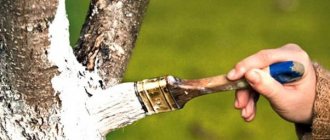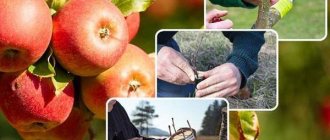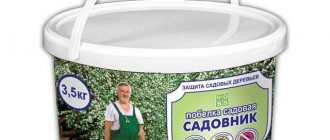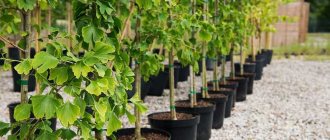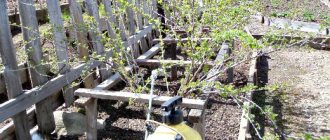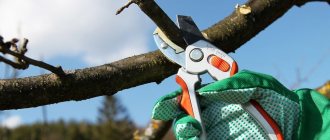Our garden is a living organism and also needs protection from adverse external influences. All spring work in the garden is aimed at protecting it, which includes: pruning, spraying, fertilizing, watering and other activities.
The list of protective works also includes spring whitewashing of the central trunk and skeletal branches of fruit trees.
Whitewashing protects the fruit tree: from spring overheating and sunburn (instead of the foliage that is still missing), and helps to destroy a significant part of the diseases and pests that have spent a successful wintering to preserve their offspring.
Spring whitewashing of garden trees
Maintaining the outer cover of a tree in a healthy condition means extending its fruiting period, the ability to avoid pesticide treatments, and obtaining an environmentally friendly harvest. Timely, properly carried out whitewashing will protect plants from damage by rodents, cracking of the bark, and will delay the onset of flowering for some time, thereby protecting them from spring frosts and other negative influences.
Why are trees whitewashed?
Many people living both in the city and in rural areas have a vague idea of why trees are whitewashed. Most believe that this is done simply for beauty. They are partly right, but there are still more important reasons for processing trunks.
Properly whitewashed wood
Why are tree trunks whitened?
- Sun protection. Direct rays are dangerous for the bark, which cracks under their influence. Therefore, tree trunks are treated with compositions of precisely white, light-reflecting colors. It is noteworthy that in winter the sun is no weaker in its impact than in summer, so it is important to protect trees all year round.
- Pest protection. Many gardeners know firsthand how often the bark of fruit trees is attacked by insects and rodents. Whitewash repels pests.
- Protection against temperature changes. Daytime heat and night cold cause the bark to deform and crack, which often leads to various types of infections getting inside the trunk. Whitewashing helps strengthen the bark, prevents the appearance of cracks, and has antibacterial properties.
Important! Trees should be whitewashed in dry weather so that the applied composition has time to set.
Main goals and objectives
Gardeners usually treat trunks in the fall. They know why trees are whitened: the procedure helps protect the bark of fruit and ornamental crops from cracking in severe frosts. At this time, all living things in nature, including insects, are preparing for the cold. They are looking for a reliable shelter where they can safely hibernate and hold out until the first warm weather. The best place for this is under the bark of a tree. You can get there by crawling into cracks. Whitewashing them in the fall will cement the weak points and prevent pests from finding a cozy home.
High-quality whitewashing of trees in the spring is a preventive measure. It is aimed at destroying pathogens that still managed to overwinter in the top layer of soil. In addition, treating skeletal branches with lime prevents burns. In spring, the sun becomes active; a simple procedure allows you to protect the bark from overheating while there is still no foliage on the crown. Therefore, experienced gardeners always whiten the trees on their site twice a year.
Whitewashing protects against sun burns Source www-cdn.intex-press.by
When to whitewash trees
Many people believe that whitewashing trees is done only in early spring. In fact, spring treatment of the trunk is intended only to renew the layer of composition that has been slightly washed away over the winter. For many, the real news is the fact that most of the work is done in the fall.
Grafting trees in spring, methods of grafting fruit trees for beginners
It is in winter that the tree especially needs protection. In February, when the sun is already noticeably warming up, and severe frosts still linger at night, the most dangerous period begins. During the day, the process of sap flow may begin in the trunk; by evening, the liquid will freeze and injure the bark. That is why it is important to whitewash in advance, in the fall. If this has not been done, you will have to process the trunks in winter, in December-January.
Timing for whitewashing trees in autumn
It is best to carry out autumn treatment in October-November, when the leaves have already fallen off and prolonged rains are behind us. You need to choose a dry, cool day when the air temperature remains at 2-3°C.
Important! There is no need to spare the solution when working so that not a single crack in the bark is left unwhitened. It is also not necessary to smear the barrel too thickly, otherwise the whitewash will crumble. It is best to coat the stem with the composition in 2-3 doses.
Rules for whitewashing fruit trees
- The whitewash layer on the trunk and skeletal branches should be up to 2 mm thick. Usually 2 layers are applied. The second - after drying the previous one.
- The solution should be homogeneous, with a creamy consistency, so as not to flow down the trunk to the ground.
- A wide, soft whitewash brush is drawn from top to bottom, without missing a single crack or scratch on the tree bark.
- It is more practical to use a spray gun.
- The painting of the trunk must be completed taking into account 4-6 centimeters in depth, for which the bottom of the trunk must be freed from the ground. After whitewashing, return the primer layer to its place.
- The top whitewash layer should be snow-white to better reflect the sun's rays.
- For mature trees, whitewashing the entire trunk and 1/3 of the skeletal branches located up to 1.8-2.0 m in height is considered sufficient. Branches covered with lichen or moss, previously cleared of them, especially need whitewashing.
- Young seedlings, according to some gardeners, are completely empty. Usually the trunk and 1/3 of the future skeletal branches are whitened.
The owner of the garden has the right to choose the type of whitewash. It, without a doubt, has a positive effect on garden crops, but under one condition: whitewashing work must become a tree care system.
How to whiten tree trunks
Grafting trees in spring, methods of grafting fruit trees for beginners
Whitewashing a tree is not difficult - just take a paint brush and apply the finishing compound to the trunk. It is advisable to paint the trunk from the very bottom, going 2 cm deep into the soil, to the roots, to the first branches. It is convenient to process fruits with a spray gun, but this will increase the consumption of whitewash.
You shouldn’t skimp on whitewashing – it won’t bring the desired result.
Covering half the barrel with white is not considered effective.
Lime for whitewashing trees
Protection from pests and diseases is the main reason why trees are whitened. Lime performs this function perfectly. Solutions based on it are easy to use, and the components used are not very expensive. As a rule, casein glue (or PVA) is added to the composition to make the whitewash stick better, and copper sulfate (as an antiseptic).
To process a large tree you will need about 1 kg of lime. It is not recommended to treat young trees with such an aggressive composition.
Is it possible to whitewash with water-based paint?
Water-based paints are quite suitable for painting trunks. They are distinguished by a higher price and ease of use - no additional components are required. However, they are not considered to be as effective as lime-based solutions.
Whitewash for trees
In specialized stores you can find a variety of preparations for whitewashing: from acrylic to chalk. Substances with reflective and antibacterial properties are added to their composition, which allows solving several problems at once.
Important! Many gardeners use a proven folk method of protecting trees - covering the trunk with a mash of clay and mullein.
Recommendations for the use and application of whitewash
When applying the solution to the trunk, adhere to the following rules. Instructions on how to whitewash trees will help even a novice gardener cope with this task:
- Whitewashing is applied in warm, windless, dry weather for better adhesion;
- Pour a 3 kg bag of lime into a galvanized bucket and fill it to the top with water. Mix thoroughly and leave to infuse for 2-3 hours. Once dissolved, add the remaining ingredients. If the lime is quicklime, use a fireproof container, as there is an increased release of heat and gases;
- When working with the solution, use protective gloves and a face respirator. The components included in the composition can cause allergic reactions, chemical burns, and make breathing difficult;
- The solution must be applied in several layers. This whitewash will last a long time, and the resulting, dried crust will serve as an additional protective layer from wind, temperature changes and insects. The photo of whitewashing trees shows a sample of classic painting and methods of applying it;
- The trunk is painted from the roots (in some cases, a 2 cm deepening into the ground is allowed) to the first branching of the branches, completely around the trunk. Experienced gardeners advise whitening all plants in the garden, both young and perennial, without exception. And process the branches at 20% of their length;
- The solution is applied in a thick layer without gaps, completely filling all the cracks. If the layer is too thick, it may crumble when it dries. Apply whitewash in 2-3 layers, completely covering the entire space;
- The finished mixture should have the structure of a paste and the consistency of thick sour cream, not drip or run off the brush;
- For application use volumetric or flat, large paint brushes. Some people use spray bottles. But with this method of application, more solution is consumed, and the whitewash layer is of insufficient thickness and quality;
- The composition of whitewash for trees may vary depending on the purpose. It may contain clay, lime, glue, copper sulfate and other components.
How to dilute lime for whitewashing
Treating trees against pests and diseases
Lime is well known not only to builders, but also to gardeners. This substance is often used to treat the trunks of mature trees. Its antibacterial properties make it possible to protect the trunk and branches from the invasion of pathogenic microorganisms.
Lime fluff
How exactly to work with lime depends on its type.
How to prevent lime from washing away
To prevent the lime from being washed off from the trees for a long time, you will need to add additional components to the whitewash. There are 2 main options for mixtures for treating trees:
- 1 kg of lime and 2 kg of clay per 10 liters of water. In this composition, clay plays the role of a fixative.
- 3 kg of lime, 300 g of vitriol and 200 g of casein glue per 10 liters of water. The glue adheres to the bark, preventing the composition from flowing under snow and rain.
How to dilute slaked lime (fluff)
Fluff lime is a slaked variety of lime that can be sold as a batter or powder. It is diluted in a 2:1 ratio, that is, 2 liters of water are taken per 1 kg of bulk or dough-like composition. At the same time, water is poured in carefully, in portions, thoroughly mixing the composition. It should have the consistency of sour cream.
As additional components you can use:
- Glue (200 g), acting as an adhesive;
- Laundry soap (40 g in the form of shavings) to enhance the antibacterial effect;
- A solution of copper sulfate (300 g per 0.5 water) instead of soap;
- Clay (300-400 g), dissolved in water to the consistency of sour cream, it is added to the solution as an adhesive.
Important! Despite the fact that fluff is slaked lime, it is better not to use it for whitewashing young seedlings with thin bark.
How to dilute quicklime
Despite the fact that it is more convenient and faster to work with slaked lime, gardeners often advise beginners to use quicklime, or rather to slak it themselves. If you follow safety precautions, this is not difficult to do.
How to extinguish lime:
- Pour lime (3 kg) into a bucket.
- Carefully fill with water (7 l).
- Stir the mixture and leave for 1-2 hours until the reaction is complete.
When the container has cooled (heat is released during extinguishing), you can add other components to the solution, the same as for the fluff.
Important! Work with quicklime must be carried out using personal protective equipment (gloves, mask, goggles).
Is it possible to whitewash trees with chalk?
It is quite possible to replace lime in whitewashing with chalk. This substance has a more gentle effect, so it is often used to treat young trees.
The following mixture is popular among gardeners: 2 kg of chalk, 400 g of copper sulfate, 100 g of casein glue per 10 liters of water.
Whitewashing process
Treat the wood in the same way as with lime whitewash, having first cleaned the bark with a brush.
At what temperature can the procedure be performed?
The spring procedure is carried out on a dry, sunny day. It is advisable that it is no higher than 5 degrees Celsius. Optimally - about 3 degrees.
If you are working with water-based paint, you will have to whiten when the temperature reaches at least 3 degrees Celsius. Recommended temperature is 7 degrees.
Also an important condition for the procedure is dry and preferably calm weather. This way the applied solution will dry on the bark and will not be washed away by the first rain.
Whitewashing should be done during the day, preferably around lunchtime (maybe a little earlier). This choice of time of day is due to the fact that the air will warm up and morning frosts (if any) will pass, and the whitewash will have time to dry before the evening cold snaps.
ON A NOTE. In summer, it is better to carry out the procedure in cloudy but not rainy weather, after about 10 a.m., but before the onset of midday heat.
How to spray trees in spring
Before spraying, the tree bark is cleaned of exfoliated areas, lichens, and adhering dirt. This can be done conveniently with a stiff brush. You can put a tarp on the ground to make it easier to remove accumulated debris.
Afterwards it is worth inspecting the barrel for damage. If there are open areas without bark, it is advisable to cover them with garden pitch.
Then you need to put on a protective suit or old thick clothing with long sleeves, gloves and a mask. Be sure to have a hat.
Prepare a solution of the drug according to the instructions and pour it into the spray bottle. Spray the branches, trunk and trunk circle, trying not to miss anything.
Note! It is advisable to notify your neighbors about the work being carried out so that they can hurry to spray the trees. Joint protection will prevent diseases from spreading from site to site.
Ingredients to improve the properties of whitewash
The following are added to the finished mixture as additional ingredients:
- Sand and clay in the proportion of 300 g. for 1 l. ready mixture. These components add strength and serve to better bond to the wood. The whitewash is thicker, and the plant is better protected;
- Glue. For 1 liter of mixture 200 ml. In this way, the mixture is given additional strength, and the whitewash lasts all season, despite high humidity and wind;
- Finely grate laundry soap and add 2 tbsp. spoons for each liter of solution. Has antibacterial, antimicrobial effects;
- Copper sulfate enhances the protective effect against whitewashing. It gives the finished mixture a bluish tint and has an antimicrobial effect. Add 0.5 kg of chemical per liter of mixture.
When to spray
Do not delay the start of treating fruit with insecticides. Insects awaken from the first warmth, so if the spring turns out to be good, the time to spray comes already in March. The most convenient time for whitewashing and spraying comes in April.
The maximum effect can be achieved by treating the trees twice. The first spraying is carried out before the buds open, when the air temperature reaches 5°C. At this time, fungal spores are already activated.
The second spraying is carried out along the green cone, that is, when the buds have already opened, but the leaves have not yet had time to bloom. At this time, flower beetle pests wake up.
Spraying in early spring
In the spring, fruit trees can be sprayed for treatment twice more: at the stage of a pink bud and ovary, the size of a pea. This will protect the crop from moniliosis and codling moth.
How much whitewashing does a garden need?
Many gardeners treat whitewashing as a decorative act and leave it for the May holidays. Meanwhile, for a longer healthy state of the tree, this is a very important maintenance procedure, and it must be carried out several times a year. According to many years of experience, whitewashing of trees should be carried out 3 times a year; whitewashing twice a day is sufficient if special, long-lasting compounds are used.
- The main whitewashing is considered to be autumn , which is carried out after the leaves have dropped and the onset of a steady cold snap (approximately October-November).
- Whitewashing is repeated in the spring , before the buds open, or rather, before the stable spring solstice (the second half of February-March, in cold regions - until mid-April).
- The third summer whitewashing is considered additional and is carried out much less frequently, although it is also necessary as protection from pests (laying eggs, emergence of larvae) and diseases (mycelium growth in bark cracks, ingress of overwintering spores).
Preparations for spraying trees
There are many products that can help rid your garden of pests.
How to spray trees in spring, the most effective preparations:
- Copper sulfate. It can not only be added to whitewash, but also used for spraying. Vitriol copes well with various types of rot, scab, and spotting. Iron sulfate has the same properties;
- Urea (urea). It is often used as a fertilizer, but it also brings considerable benefits in pest control. Fights coccomycosis, moniliosis, rot;
- Bordeaux mixture. An indispensable gardener's assistant that can be used to treat trees and shrubs before flowering.
Knowing what and when to whiten trees in the spring, you can protect your harvest from many troubles. Lime works well against pests, diseases and bark destruction. Chalk and acrylic-based paints are no less effective. A solution with additional components will last a long time, preventing the trees from getting sick.
Is spring whitewashing required?
In the spring, with the onset of bright sunny days, dark bare trunks and skeletal branches of trees warm up to +8...+12°C, that is, to the temperature at which sap flow begins. Remember, “...the sound of spring is coming and humming”? A nighttime drop in temperature to sub-zero values causes the sap to freeze and, in accordance with physical laws, as it expands, it ruptures internal tissues and causes cracks to appear in the bark, especially young ones. The white color of whitewash reflects the sun's rays well and reduces the heating temperature. The trees now continue to be no longer in natural, but forced rest (without sap flow). They begin to vegetate and bloom later, which preserves not only the health of the trees, but also the harvest.
If for various reasons the February-March period is missed, then it is not too late to whiten the trees in the first half of April.
Using similar processing tools
In addition to the popular whitewashing with lime, solutions based on other ingredients are used. They are used as substitutes or to complement lime mortar.
